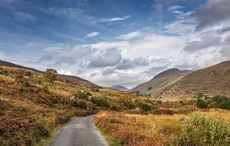Three miles out to sea, stark against the western horizon, storm clouds are swirling above the Great Blasket. The future of this unique island, renowned for its desolate beauty, its crumbling ruins and its cultural legacy, is under threat.
After years of agitation, litigation, and endless negotiations, the Irish government declared last July its intention to purchase the island - the ?rst step towards the island being declared a national heritage site and perhaps a UNESCO world heritage site. They also published their proposed management plan.
The initial reaction to the plan was overwhelmingly positive. "I was thrilled that my childhood home, a place of such cultural importance, was going to be conserved for the future," says former island dweller Niamh Uí Laoithe.
"Everyone was delighted," she continues. "After years of talks, the complex jigsaw of landowners' rights, tourism interests and management issues was finally fitting together."
In the intervening months, much has happened to sour this optimism. Piece by piece, the jigsaw is falling apart. "Landowners are refusing to sell," says Peter Callery, the majority landowner on the island. "Ferry boat owners are up in arms. And the government is being swayed by all the vested interests. No progress has been made and the island's future is in serious doubt."
The Great Blasket Island comprises just over 1,000 acres. Why is it attracting so much attention? Why are so many people interested in its future?
The answer lies in the past. Niamh Uí Laoithe, Nell Uí Shé, another ex-islander, and Mícheál de Mórdha, director of the Great Blasket Heritage Centre, recount the island's long history.
The island ?rst came to prominence early in the twentieth century when academics became interested in the life of its community. "It was a place outside of time," explains Mícheál. "The islanders' way of life had remained unchanged for generations. Raising their own food, gathering seaweed to fertilize the land and ?shing the seas - they shared their labor and its rewards."
Niamh adds that exposure to the modern world began to erode this way of life. "It happened slowly at first," she says, "but soon it was irreversible. Cash replaced bartering. Fishing declined. And then the young and the strong began to emigrate."
Encouraged by the visiting academics, some older people on the island wrote their memoirs. This literary legacy offers a rare insight into the social customs of a pre-modern society.
"One day, there will be none left on the Blasket of all I have mentioned in this book and none to remember them," writes Tomás " Criomhthain in his memoir, The Islandman. "I am thankful to God who has given me the chance to preserve from forgetfulness those days I have seen with my own eyes...When I am gone, men will know what life was like in my time and the neighbors that lived with me."
Niamh is Tomás' granddaughter. Both she and Nell are proud of their heritage. "Our close-knit community was unlike any other," says Nell. "We looked after each other. Life was hard but it was good."
The changing times forced Nell and Niamh to leave their island home. Nell left in the 1930s in search of a job on the mainland; Niamh and her family in the 1940s after the school closed. "It broke our hearts but there was nothing there for us anymore," says Niamh.
The Great Blasket Island was dying. Its death knell was struck in 1953 when a storm isolated the islanders for many days. Running out of food, they sent an emergency telegram to the Taoiseach ...amonn de Valera appealing for help. He came to their aid but also decided that it was too dangerous to allow people to continue living on the island. Under his orders, the last of the islanders left the Great Blasket on the 17th of November, 1953.
The book of the island was closed; its final chapter written. "Or so we thought," says Mícheál. "In reality, it was a whole new beginning."
After the evacuation, life on the island took on a new guise. Freed from human intervention, nature blossomed - animals roamed, bird colonies thrived and flowers bloomed.
"Nature has truly taken over," says Eamonn de Buitléar, an environmental ?lmmaker who has been visiting the island since the 1960s.
"Grey seals on the beach and Manx shearwaters, storm petrels, choughs, puffins and other wonderful colonies of birds in the skies; the island is paradise for nature-lovers like me."
Artists are inspired by the island's dramatic scenery and the ghostly nature of its abandoned buildings. Maria Simonds-Gooding, a well-known graphic artist, first visited in 1964 and was captivated. She describes it vividly: "I recognized instantly that it was the place for me. The Great Blasket has a haunting beauty and a special energy that hasn't been corroded by time".
Academics first arrived in the early twentieth century. Today, intrigued by the literature, they continue to come. Schoolteacher Mícheál " Dubhshláinne explains his love of the Great Blasket. "After reading the books, I was deeply affected. I promised myself I'd visit the island as soon as ever I could."
He fulfilled his ambition when he came to work as a teacher in Dunquin primary school (which overlooks the island) in 1970. "The more I learned about the island, its history and its people, the more inspired I was," he says. "Soon, I too began to write." Mícheál has now published two books about the island. "I suppose you could say the Blasket literary tradition continues," he says, laughing.
Others, like Sue Redican, were drawn by the sense of peace. She first visited the island in 1986 and has since spent every summer there. "I was seduced by the silence," she says. "It was so far removed from the modern world. It drew me back again and again."
Sue, a weaver, sets up her loom in one of the old houses. "I work all day, making cloth for shawls and blankets. People call in and we share a cup of tea. My life is slow and peaceful - just the way I like it."
These people make up the island's community every summer. They are joined by returning islanders. The Dunleavy family visits every year. They whitewash their cottage, fix the roof and live in the old ways.
"My family has been here for three hundred years," says Seán Dunleavy, proudly. "We will never lose our links with this land. We are steeped in its traditions. To us, this island is very much alive. We are its next generation."
So it continued until 1985 when the Great Blasket Island was faced with its next challenge. In that year, The Wall Street Journal advertised that the island was for sale.
"My family home was going to be passed into the hands of strangers," remembers islander Niamh. Horrified at the prospect, she became involved with a campaign urging the government to purchase the island and turn it into a national park.
This summer, when the government made their long-awaited announcement and published the management plan, it marked the end of twenty years of acrimonious court cases and hard-won battles for Niamh and her fellow campaigners. "We were elated," she says. "Little did we suspect that storm clouds were looming."
The management plan was agreed upon by the island's landowners, cultural groups and the government. Others - many with close personal ties to the island - feel excluded and oppose the plan. "We have a part to play in the life of the island too. Why were we not consulted?" asks weaver Sue Redican.
Part of the plan includes constructing a building to house a new café, hostel, public toilets, accommodation for the island's rangers and small of?ces. Artist Maria Simonds-Gooding is fiercely opposed. "For now, island life is simple," she says. "The physical hardship encourages a real sense of community. You rely on nature. You rely on others. It's like stepping outside of modern times. If we make the island more comfortable, if we add this and that, we risk losing what makes the island so unique."
A complaint was lodged by An Taisce (a heritage agency) which has resulted in planning permission being denied, for the moment. "So now we have the ridiculous situation where hundreds of people a day are being allowed onto an island that doesn't have toilet facilities," fumes landowner Peter Callery, who supports the plan.
Others are apprehensive about the number of visitors allowed on the island. Environmentalist ...amonn de Buitléar considers the limit of 400 people a day too high. "With this amount of people roaming freely around the island, damage will be done to the wildlife," he warns.
Money and avarice have complicated matters. The plan allows for Peter Callery to continue with his small café and hostel business but a ban has been placed on any other commercial ventures.
Objections are rife and tempers fraught. Other landowners would like to develop businesses and resent the fact that they are not allowed to do so. Some are now refusing to sell their land unless they too are given commercial rights.
The government's lack of momentum is causing problems of its own. The landowners have not received any communication from the government since the announcement in July. They are beginning to worry.
"They've ground to a standstill," states Peter Callery. "Under pressure from all sides, they don't know how to proceed. Meanwhile, we are left in the lurch. If this goes on much longer, we landowners will have to reconsider our positions. We agreed on a price for our land three years ago. Prices have increased since then. Maybe we should ask for more."
Unperturbed by the implied threat, the government has declared that it is fully committed to the project. "We are pleased with the progress of negotiations so far and look forward to moving onto the next phase of development," says an of?cial spokesperson.
Perhaps they are distracted? As well as attempting to solve the land disputes, the government is also struggling to placate angry ferrymen.
Once the land has been transferred to the state, the next step is to construct new piers in Dunquin and on the island. This will allow more people to visit the island and will provide more business for the ferrymen.
For the past four years, Peter Callery has operated a ferry service from Dingle, the closest town. According to the management plan, he and ferry boat operators sailing from Dunquin will now have to share their business, with his boat getting 25 percent of all passengers.
The Dunquin operators are livid. "It's completely unfair," complains Mick Sheeran, one of the boatmen. "It's obvious to us that Peter Callery used his in?uence as a landowner to gain advantage for his ferry boat. We are going to fight this."
Mick and several others are appealing this aspect of the plan, while another ferryboat owner is contesting his right to operate a boat out of Dingle.
"We never suspected that there would be so many problems," says islander Niamh. "After all our discussions, the future of the island is still in dispute."
Some people are losing hope. "The government do not instil confidence," says Peter Callery. "If they were committed to preserving this island, they'd have done so years ago."
Niamh, however, remains optimistic. "I still believe that the only reason the government is taking so long is that they want to do it right. They won't do the island any harm, only good."
In the midst of this confusion, only one thing is certain. While these debates and disputes rage, the buildings on the island continue to fall into ruin. "We are losing perspective," says Mícheál de Mórdha of the heritage centre. "The buildings are disappearing back into the mountain from which they came while we stand around arguing. We must act now if we want to save the island." This latest chapter of the island's history may just prove to be the most crucial of all.




Comments